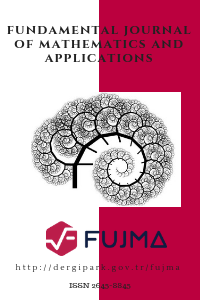Rank Approach for Equality Relations of BLUPs in Linear Mixed Model and its Transformed Model
Rank Approach for Equality Relations of BLUPs in Linear Mixed Model and its Transformed Model
BLUP, covariance matrix linear mixed model, rank, transformed model,
___
- [1] C. R. Rao, Representations of best linear unbiased estimators in the Gauss–Markoff model with a singular dispersion matrix, J. Multivariate Anal., 3 (1973), 276-292.
- [2] B. Dong, W. Guo, Y. Tian, On relations between BLUEs under two transformed linear models, J. Multivariate Anal., 131 (2014), 279-292.
- [3] Y. Tian, Matrix rank and inertia formulas in the analysis of general linear models, Open Math., 15 (1) (2017), 126-150.
- [4] G. Marsaglia, G. P. H. Styan, Equalities and inequalities for ranks of matrices, Linear Multilinear Algebra, 2 (1974), 269-292.
- [5] Y. Tian, Equalities and inequalities for inertias of Hermitian matrices with applications, Linear Algebra Appl., 433 (2010), 263-296.
- [6] B. Arendack´a, S. Puntanen, Further remarks on the connection between fixed linear model and mixed linear model, Stat. Papers, 56 (4) (2015), 1235-1247.
- [7] H. Brown, R. Prescott, Applied Mixed Models in Medicine, 2nd edn, Wiley, England, 2006.
- [8] E. Demidenko, Mixed models: Theory and applications, Wiley, New York, 2004.
- [9] D. Harville, Extension of the Gauss–Markov theorem to include the estimation of random effects, The Annals of Statistics, 4 (1976), 384-395.
- [10] S. J. Haslett, S. Puntanen, On the equality of the BLUPs under two linear mixed models, Metrika, 74 (2011), 381-395.
- [11] S. J. Haslett, S. Puntanen, A review of conditions under which BLUEs and/or BLUPs in one linear mixed model are also BLUEs and/or BLUPs in another, Calcutta Statistical Association Bulletin, 65 (1-4) (2013), 25-42.
- [12] J. Jiang, Linear and generalized linear mixed models and their applications, Springer, New York, 2007.
- [13] Y. Liu, On equality of ordinary least squares estimator, best linear unbiased estimator and best linear unbiased predictor in the general linear model, J. Statist. Plann. Inference, 139 (2009), 1522-1529.
- [14] X. Q. Liu, J. Y. Rong, X. Y. Liu, Best linear unbiased prediction for linear combinations in general mixed linear models, J. Multivariate Anal., 99 (2008), 1503-1517.
- [15] X. Liu, Q. W. Wang, Equality of the BLUPs under the mixed linear model when random components and errors are correlated, J. Multivariate Anal., 116 (2013), 297-309.
- [16] G. K. Robinson, That BLUP is a good thing: the estimation of random effects (with discussion on pp. 32-51), Stat. Sci., 6 (1991), 15-51.
- [17] Y. Tian, A new derivation of BLUPs under random-effects model, Metrika, 78 (2015), 905-918.
- [18] Y. Tian, B. Jiang, An algebraic study of BLUPs under two linear random-effects models with correlated covariance matrices, Linear Multilinear Algebra, 64 (12) (2016), 2351-2367.
- [19] Q. W. Wang, X. Liu, The equalities of BLUPs for linear combinations under two general linear mixed models, Commun. Stat.–Theory and Methods, 42 (2013), 3528-3543.
- [20] J. K. Baksalary, S. Kala, Linear transformations preserving best linear unbiased estimators in a general Gauss–Markoff model, Ann. Stat., 9 (1981), 913-916. [21] N. G¨uler, On relations between BLUPs under two transformed linear random-effects models, Communications in Statistics–Simulation and Computation, (2020), doi:10.1080/03610918.2020.1757709.
- [22] E. P. Liski, G. Trenkler, J. Grob, Estimation from transformed data under the linear regression model, Statistics, 29 (1997), 205-219.
- [23] C. H. Morrell, J. D. Pearson, L. J. Brant, Linear transformations of linear mixed-effects models, Am Stat., 51 (1997), 338-343.
- [24] J. Shao, J. Zhang, A transformation approach in linear mixed-effects models with informative missing responses, Biometrika, 102 (2015), 107-119.
- [25] Y. Tian, On properties of BLUEs under general linear regression models, J. Statist. Plann. Inference, 143 (2013), 771-782.
- [26] Y. Tian, Transformation approaches of linear random-effects models, Stat. Methods Appl., 26 (4) (2017), 583-608.
- [27] Y. Tian, C. Liu, Some equalities for estimations of variance components in a general linear model and its restricted and transformed models, Multivariate Anal., 101 (2010), 1959-1969.
- [28] Y. Tian, S. Puntanen, On the equivalence of estimations under a general linear model and its transformed models, Linear Algebra Appl., 430 (2009),2622-2641.
- [29] I. S. Alalouf, G. P. H. Styan, Characterizations of estimability in the general linear model, Ann. Stat., 7 (1979), 194-200.
- [30] A. S. Goldberger, Best linear unbiased prediction in the generalized linear regression model, J. Amer. Statist. Assoc., 57 (1962), 369-375.
- [31] S. Puntanen, G. P. H. Styan, J. Isotalo, Matrix Tricks for Linear Statistical Models: Our Personal Top Twenty, Springer, Heidelberg, 2011.
- ISSN: 2645-8845
- Yayın Aralığı: Yılda 4 Sayı
- Başlangıç: 2018
- Yayıncı: Fuat USTA
Some New Traveling Wave Solutions of Nonlinear Fluid Models via the MSE Method
Gizel BAKICIERLER, Emine MISIRLI
Some Fixed Point Theorems on $b$-$\theta$-metric spaces via $b$-simulation Functions
Esra DALAN YILDIRIM, Ayşegül ÇAKSU GÜLER, Oya Bedre ÖZBAKIR
Rank Approach for Equality Relations of BLUPs in Linear Mixed Model and its Transformed Model
Melek ERİŞ BÜYÜKKAYA, Nesrin GÜLER, Melike YİĞİT
Special Ruled Surface in de-Sitter 3-Space
Tubular Surfaces Around a Null Curve and Its Spherical Images
Numerical Algorithm for Solving General Linear Elliptic Quaternionic Matrix Equations
Kemal EREN, Hidayet Hüda KÖSAL
Some Approximation Results on $\lambda-$ Szasz-Mirakjan-Kantorovich Operators
